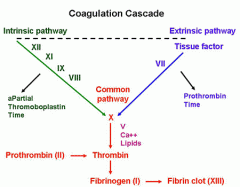![]()
![]()
![]()
Use LEFT and RIGHT arrow keys to navigate between flashcards;
Use UP and DOWN arrow keys to flip the card;
H to show hint;
A reads text to speech;
13 Cards in this Set
- Front
- Back
|
What is the function of blood? Give examples |
- transporation: O2 to cells, CO2 from cells, hormones, heat, waste products - regulation: blood pH, temperature, osmotic pressure - protection: innate and adaptive immune responses, clotting |
|
|
How much blood in in the body? |
-5-6 litres in males, 4-5 litres in females |
|
|
What is blood composed of? |
-two main components: blood plasma (~55%) and formed elements (99%RBC) (~45%).leukocytes and platelets make up <1% of blood - plasma is mostlywater (~90%); remaining amount is solutes (mainly proteins) (~10%). containsimmunoglobulins, nutrients, electrolytes, regulatory substances (e.g.enzymes, hormones and vitamins) and wastes (e.g. urea, uric acid andammonia) - formed elements has three main components: RBCs, WBCs and platelets. Mainly composed of RBCs: 99% |
|
|
What is the difference between haemopoiesis and erythropoiesis? What triggers cell production? |
- haemopoiesis is a general term for the generation blood cells. Erythropoiesis is specific to RBCs - erythropoiesis is triggered by negative feedback in response to hypoxia; WBCs are restored asrequired in response to pathogens/foreign antigens |
|
|
Describe the different stages of haemopoiesis? |
- pluripotent stem cellsin the red bone marrow differentiate into haematopoietic stem cells(multipotent) - haematopoietic stemcells differentiate into myeloid and lymphoid cells (oligopotent) - myeloid cells give riseto committed progenitor cells, which produce terminallydifferentiated RBCs, platelets, monocytes, neutrophils, eosinophilsand basophils - lymphoid cells giverise to committed progenitor cells. They begin the development in thered bone marrow but become terminally differentiated lymphocytes inlymphatic tissues (e.g. primary lymphatic organs) |
|
|
Describe the different stages of erythropoiesis? |
- triggered in response to hypoxia e.g. altitude, anaemia, causing the kidneys to release erythropoietin - begins in bone marrowwith a proerythroblast - goes through variousstages of division into cells which produced haemoglobin - When it forms aorthochromatic erythroblast, it undergoes denucleation, turning intoa reticulocyte. - denucleation causesthe characteristic biconcave indentation of RBCs - reticulocytes arereleased into the blood stream. At this stage they still retain somemitochondria, ribosomes and endoplasmic reticulum. - within 1-2 days thereticulocyte develops into a mature erythrocyte |
|
|
Describe the life cycle of RBCs |
(1) macrophages in thespleen, liver or red bone marrow phagocytose RBCs which have rupturedor are worn out (2) 4 globin chains andheme groups are split (3) globin chains arebroken down to amino acids to be reused (4) iron (Fe3+)is removed from the heme groups and transported by a bloodstreamplasma protein, transferrin (5) Fe3+detaches from trasnferrin in muscle fibres, liver cells, and thespleen and liver, and binds to the storage protein, ferritin. (6) In thegastrointestinal tract, Fe3+reattaches to transferrin (7) Fe3+is transported to the bone marrow where it is taken up RBC precursorsvia endocytosis. (8) Erythropoiesis occursin the red bone marrow (9) Non-iron componentsof heme are converted to biliverdin, and then bilirubin. (10) Bilirubin enters thebloodstream where it is take to the liver (11) Bilirubin in theliver is released into bile and transported to the small, then largeintestine (12) bilirubin isconverted to urobilinogen by bacteria (13) some urobilinogen isreabsorbed and converted into urobilin (14) the remainingurobilinogen is excreted in the form of stercobilin |
|
|
What is haemostasis? What are its three main mechanisms? |
Haemostasisis a range of responses involved in preventing bleeding. There arethree main mechanisms; (1) vascular spasm, (2) platelet plugformation, and (3) coagulation. |
|
|
Describe vascular spasm |
-occurs when there is damage to vascular smooth muscle -arteries and arterioles contract to reduce blood flow/loss |
|
|
Describe platelet plug formation |
(1) Platelet adhesion:platelets stick to components of the damaged blood vessel – such ascollagen fibres (2) Platelet releaseaction: adhesion of platelets causes them to become activated.Projections from the platelets begin to extend outwards allowingplatelets to contact one another. The platelets then release variouschemicals from their vesicles. Notable examples include;Adenosine Diphosphate(ADP) and thromboxane A2: activate nearby platelets.Serotonin andthromboxane A2: maintaining vasoconstriction (3) Plateletaggregation: Due to components such as ADP, platelets continue tobe recruited and stick to the originally activated platelets –forming a platelet plug. |
|
|
Draw the coagulation cascade |

|
|
|
What is the importance of vitamin K in clotting |
thoughnot involved directly in clotting, it is involved in the synthesis offour clotting factors: II, VII, IX, and X |
|
|
What if the first aid for simple cuts? |
(1) clean wound asrequired using water or alcohol-free wipes (2) If possible, raiseinjury above heart (3) wash surrounding area– wiping away from wound - and apply a dressing or plaster (4) if the woundcontinues to bleed or if there is a higher risk of infection (e.g.embedded object) seek help |

